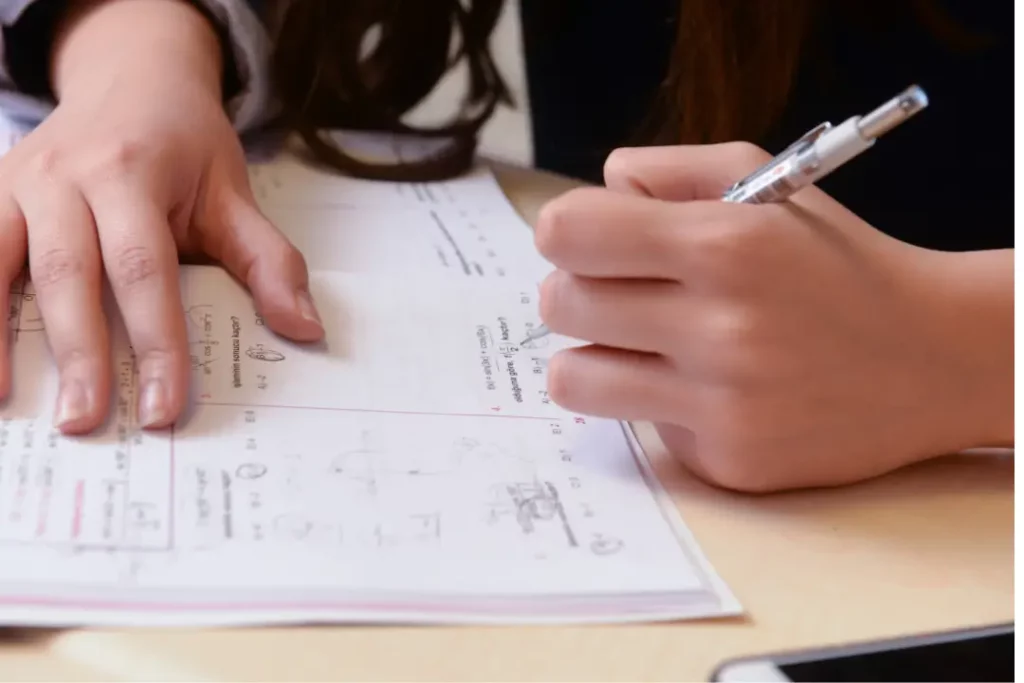
The math test is looming. You’ve reviewed your notes from class by carefully reading and re-reading every word. With your notes, homework, graded quizzes, and textbook laid out beside you so that you can look for a hint if you get stuck, you work through many examples from the notes and the textbook. You believe that you are ready to successfully take the test and at long last earn that ever elusive higher grade. When the graded test is returned to you, the grade doesn’t reflect your hard work at all! You wonder, “How do I study for a math test?”
Studying for a math test can feel overwhelming—but it doesn’t have to be. If you’ve ever spent hours reviewing notes only to freeze up on test day, you’re not alone. While reading the textbook, reviewing notes, and reworking problems are helpful starting points, real success comes from active strategies that boost your understanding and confidence. In this article, we’ll walk you through smart, effective steps so you’ll know exactly how to study for a math test, ensuring you approach the exam with confidence.
How to Study for a Math Test
The best way to study for most math tests is to create your own comprehensive practice test. It also helps pinpoint questions to ask your teacher. Ensure your practice test covers all concepts and question types that might appear on the actual exam. By proactively identifying weaknesses, you can gain the academic edge you are seeking.
Building Your Own Practice Math Test

You can easily create a personalized practice test using materials you already have.
Step 1: Gather the Right Problems
Start by reviewing worked examples from your class notes, textbook examples, assigned homework problems, and free online resources, like lessons on Khan Academy which offers free resources for nearly every math topic and grade level. Select one problem of each type that your teacher assigned or emphasized in class. Prioritize problems for which you have both the complete solution and the correct answer readily available.
Step 2: Make Practice Notecards
Next, gather a stack of blank notecards. On the front of each card, clearly write the problem itself along with the minimum necessary instructions. On the back of the same card, note the relevant section number and title, the original problem number, and the correct answer.
For example:
Front of card: Write the problem and instructions (e.g., “Find the exact value of cos(75°)”).
Back of card: Include the section number and title, original problem reference, and correct answer (e.g., “Section 7.3 Sum and Difference Formulas, Example 2, Answer: (√6 – √2)/4”).
Create one notecard for each problem you have chosen. This collection of notecards will form your initial practice test question bank.
Step 3: Simulate Test Conditions
To simulate test conditions accurately, determine the time you will have per question on the actual test by dividing the total test time by the number of questions. Then, gather your notecard stack, the calculator and formula sheet you will use during the actual test (if permitted), a timer, and scratch paper. Shuffle your notecards thoroughly to randomize the order of the problems, ensuring the question side is facing up. Start the timer and begin working through the problems one by one. It is crucial to take this practice test under conditions that closely mirror those you will experience during the actual exam.
Step 4: Review and Reflect
After finishing, review your answers:
Problems you got wrong or couldn’t solve: Go back to your notes or textbook and study the concept again. Then, either reuse the original notecard or make a new one with a similar problem. Set this card aside for further review.
Problems you solved correctly but didn’t feel confident about: Even if your answer was right, if you weren’t sure of your method, that’s a sign you need more practice. Restudy the concept and make a similar notecard for extra practice. Set this card aside too.
Problems you eventually solved but didn’t know how to start at first: Think about what clues in the question could’ve pointed you to the right method. For example, if the problem asked for the exact value of cos(75°), you should have recognized that an identity is needed because 75° isn’t a standard angle. Make a new notecard like it and add it to your review pile.
Problems that took too long: Review your solution process to see where you could save time. Cut out any unnecessary steps or formulas that didn’t help. A new practice card might be helpful, but it’s not always necessary.
Problems you solved easily and correctly (or made only a small mistake): If you were confident and quick, you don’t need more practice on that topic—no need to make another notecard.
Step 5: Repeat the Process
Next, use your newly created stack of notecards for another focused practice test, repeating the review process. If certain questions continue to be challenging, seek help from your teacher, as you will now have specific questions for them.
Avoiding Common Math Test Study Mistakes

Students often make several preventable errors when preparing for math exams. To maximize your success, avoid these pitfalls:
- Waiting until the test to work problems independently: Your initial attempts at solving problems without notes, textbooks, or other aids should occur well before the actual test.
- Only working problems in order: Practice solving problems out of the sequence presented in your textbook or notes. Knowing the section a problem comes from can unintentionally guide your solution method.
- Waiting until test day for test conditions: Simulate test conditions by working through practice problems under timed constraints.
- Misunderstanding the purpose of a formula sheet: Even if a formula sheet is provided, you still need to study and familiarize yourself with the formulas. The sheet serves as a reminder of specific details, not a substitute for understanding when and how to apply the formulas. Your first time using the formula sheet to solve problems should be during practice, not the test.
- Neglecting formula memorization: While formula sheets reduce the pressure to recall every detail, you still need to learn the formulas well enough to recognize when they are needed and understand their basic structure. For instance, knowing there is a formula for cos(A+B) and having a general idea of its components is crucial, but the formula sheet will provide you with the specific details of the formula.
How Many Hours Should You Spend Studying for a Math Test?
There is no set number of study hours that will guarantee an A on your next math test. To be successful, focus on the quality of your study time rather than just the quantity of hours spent. Creating and utilizing a practice test made of notecards is a powerful strategy to prepare for a math test. This method helps identify areas needing further study, encourages practice under realistic test conditions, and promotes deeper understanding of concepts.
For a comprehensive guide on cultivating a positive and successful routine, visit our blog post “How to Build Good Study Habits: The Ultimate Guide.”
Conclusion
By avoiding common study mistakes and focusing on active problem-solving, students can significantly improve their test performance and achieve better grades in mathematics. So here’s to earning an A on the next math test!
Mastering how to study for a math test takes strategy and practice. If you’re looking for more personalized support, reach out to HelloCollege to learn how working with a private academic tutor can help you study more effectively and boost your confidence.








